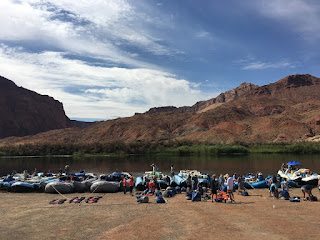 |
| Photo by Greg Bryan |
With the safety briefing behind him, Ted got to the real advice: bring more beer. I'm starting to see a theme here. There was a small convenience store next to the lodge, and Ted made the excellent point that the price of one more 18 pack was nothing compared to the emotional cost of running out of beer at the bottom of the Grand Canyon. And Ted reassured us that any beer remaining at the end of the trip would be donated to the River Guide Scholarship Fund. So really, how could we say no?
Which is how we arrived at the photo above. In the 100+ trips that Ted has been a part of, he has never had to pack so much beer on the boat. We were (mostly) proud about that.
But our trip was clearly different in several ways. One of Dean's tasks throughout the off season is to call guests with future reservations to make sure they know that they're getting into. The trips aren't cheap. And the average guest who can afford to make the trip is not the type of person that is used to pooping in a bucket. Dean has to slowly ease them into that realization. And they're also not the type of people who bring so much beer that the trip leader wonders out loud if he's going to have enough room to pack the toilet paper.
About half of this trip was the Jill's 40th group, and the other half were groups of two to six that we met that morning. When Dean made the guest phone calls for this particular trip, he actually warned them that half of the group was going to be a bunch of late 30-somethings without their kids, and the brave souls that kept their reservations were clearly a very cool bunch.
So we loaded up on the vans and made our way down to Lee's Ferry. The van ride was only a few minutes, but it was far enough to watch our cell phone reception drop down to nothing. This was going to be delightful.
We spent a few minutes stuffing our backpacks into the GCW-provided dry bags, and sizing up our lifejackets. The guides buzzed around us, packing up the gear, and continuing to wonder out loud where they could possibly fit all this beer.
Lee's Ferry was buzzing that morning. We were leaving in the middle of peak season, so there were actually four trips launching at various points throughout the day.
We were the first group scheduled to leave that morning, which would put us at a distinct advantage for snagging the best campsites. But one of the best parts of going with a professional outfitter is that I didn't have to worry about any of that. Aimee and I have toyed with the idea over the years of securing our own permit and renting boats for a private trip. But as I watched the amount of orchestration required to get these boats in the water (with enough gear, water, food, and safety equipment, to say nothing of beer), I had the first of several confirmatory thoughts that we had made the right decision.
With the bags tied down, and the last of the beers wedged into any remaining storage compartment, we were off!
Those smiles brought to you by the thought of ten children at home with their grandparents.
And Curtis, our new friend who at the exact moment this picture was taken seemed to realize what he got himself into.
The first landmark on our voyage was the Navajo bridges that Aimee and I walked over a few hours earlier.
The smaller one was built in 1929, and was the first surface level crossing of the Grand Canyon. Lee's Ferry had been the only other way to cross the Colorado River, and was subject to weather and river conditions. Plus, it wasn't designed for automobile traffic, which was becoming the ferry's main business. Predictably, the ferry crossing service shut down around that time.
The original single lane bridge served the canyon until 1995, when a similar-looking bridge was built. The significantly increased number of crossings warranted the construction of a new bridges with two lanes that conformed to modern highway standards. We drove across it as we were pulling in to Marble Canyon Lodge the night before.
Fun fact: If the Glen Canyon damn ever burst (extremely unlikely because of it's intentionally overbuilt design), the Navajo bridges would be under 100 feet of water within minutes. Enjoy the trip, river campers!



